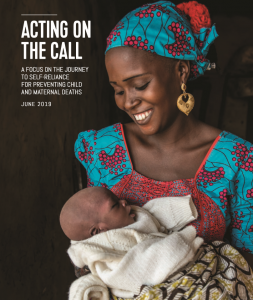
Over the past five years, the U.S. Agency for International Development (USAID) identified and refined its strategy to prevent child and maternal deaths in annual Acting on the Call reports. This strategy represents USAID’s approach to pursuing the greatest improvements in maternal and child survival by scaling up high-impact interventions to those who need them most, while simultaneously addressing key health constraints. The Acting on the Call reports lay out, and provide updates on, USAID’s commitment to prevent child and maternal deaths.
A key component of this effort is building countries’ capacity to effectively manage their own health care. Since 2012, the governments in more than half of USAID’s priority countries for maternal and child survival have increased their domestic budgets for health. Having demonstrated the potential results achievable through our strategy, we continue to look for new opportunities to improve our programs and refine our approach.
In the 2018 Acting on the Call report, we examined what the Journey to Self Reliance means for health and where our priority countries are on their respective paths. Many countries are at the beginning of their journeys, and none are nearing the end, which presents USAID with the opportunity to reorient our funding to both accelerate progress and help these countries transform into self-reliant nations for health.
In this Acting on the Call report, we examine how we can best work with countries on their development journeys. As we refine our programs, we are taking a hard look at aligning our strategy with USAID’s approach to fostering self-reliance and key principles that can accelerate progress globally. Our existing strategy already optimizes impact by integrating funding across health investments that contribute to preventing maternal and child deaths. We also have looked closely at how we must tailor a mix of interventions to the local context to meet countries where they are and truly advance progress.
The goal of foreign assistance is to end its need to exist. As countries move along the Journey to Self-Reliance, USAID’s role increasingly becomes that of a catalyst for new ideas, partners, and resources to help meet national goals. By working with governments, other donors, civil society, faith-based organizations, and the private sector, we can save the lives of 15 million children and 600,000 women between 2012 and 2020. Through targeted investments, USAID helps countries meet the targets laid out in the 2014 Acting on the Call report, as well as the relevant global targets to reduce child mortality to 25 deaths per 1,000 live births and maternal mortality to a global average of 70 deaths per 100,000 live births by 2030.
USAID’s impact since the 2012 Call to Action:
- 13.3M health workers trained in maternal and child health and nutrition
- 12M women gave birth in a health facility
- 9.3M newborns reached with care after delivery
- 85.2M treatments provided to children for diarrhea and pneumonia
- 41.1M children vaccinated against deadly preventable diseases
- 14.9M people gaining access to basic drinking water
- 24M women reached with voluntary family planning services, annually
- 28M children reached with nutrition programs